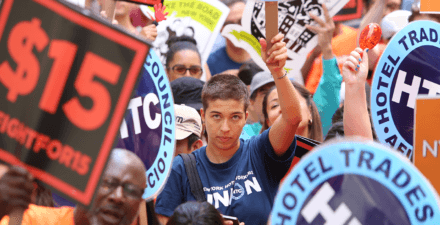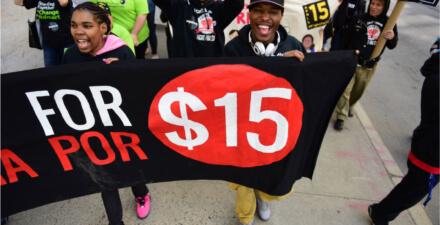New research finds $15 minimum wages raise pay and increase employment for low-wage workers

Increasing the minimum wage has repeatedly been shown to raise the pay of low-wage workers and improve the overall economy. While the federal minimum wage remains at its 2009 level of $7.25 per hour, 30 states and dozens of cities, as well as Washington, DC, have instituted much higher wage floors.
Our new working paper, “Minimum Wage Effects and Monopsony Explanations,” examines the effects of the boldest such policies: the near-doubling of minimum wages—to $15 per hour—in California and New York between 2013 and 2022. We find that these large minimum wage increases both raised pay for workers at the bottom of the earnings ladder and increased employment.
We focus on the lowest-wage workers—those employed in the fast-food industry and teen workers—who are often considered the most vulnerable to losing their jobs when minimum wages rise. Nonetheless, we find positive earnings and positive employment effects for both groups of workers in both states.
Our study uses data from the U.S. Bureau of Labor Statistics and the U.S. Census Bureau to study 47 large and mid-sized counties from these two states. Average wages in these counties span the distribution of average wages in counties across the United States. Our findings therefore contain lessons that are likely to apply to the entire country.
We compare each of these counties to a matched combination of counties that had similar wage and employment trajectories before 2013 and are in the 20 states where the minimum wage has remained at $7.25 since 2009. This state-of-the-art estimating strategy—which we call a stacked county-level synthetic control—is especially suited to studying the effects of a series of repeated policy events, such as annual minimum wage increases, in multiple locations.
We find substantial earnings increases and positive employment impacts. We also find that the employment effects are concentrated largely just below and above the new $15 minimum wage, with no significant effects for those higher up the earnings ladder. This result gives us confidence that our methods are not generating spurious positive employment effects.
Some of the 47 counties we study implemented higher local minimum wages on top of the state-level $15 mandate; a few others had relatively higher wages than almost all other U.S. counties. In both groups, the effects of the state-level $15 minimum wage are likely to be very small, which could lead to biased estimates of the effects of the state-level increases in more typical counties. When we remove these outlier counties from our sample, we find a larger and statistically significant positive effect on employment.
Using simple back-of-the-envelope calculations, we estimate that the higher minimum wage in California and New York resulted in 39,000 more employed fast-food workers.
How it is possible that an increase in the cost of labor could result in greater employment, rather than less? The answer is that the competitive market model of Econ 101 textbooks does not fit the reality of many low-wage labor markets. Indeed, our results are consistent with a growing body of research on what economists call monopsony power.
Monopsonistic employers face less vigorous competition from other employers. They therefore can—and do—pay workers considerably less than if they faced such competition in the labor market. Lower wages, in turn, cause employees to quit their jobs more often and make the jobs less attractive to other workers. As a result, low-wage employers typically have large numbers of unfilled job vacancies.
Higher wages decrease this churn and reduce the number of open positions at any given time—in other words, increasing the number of filled jobs. Our study finds that the higher minimum wages in California and New York did indeed reduce employee quits, demonstrating how minimum wages can increase employment.
We also examined how profit margins at McDonald’s restaurants in the 47 counties reacted to the minimum wage increases. In theory, lower wages allow monopsonistic firms to make higher profits; higher minimum wages would reduce those profits. We find that profit margins at McDonald’s did indeed fall when minimum wages rose—another indication that the new minimum wage policies worked to overcome employer power.
Our study indicates that a $15 minimum wage does not cause negative employment effects in these monopsonistic environments. Rather, it can raise living standards and employment rates among low-wage workers, creating a more equitable U.S. labor market and generating more equitable economic growth.







